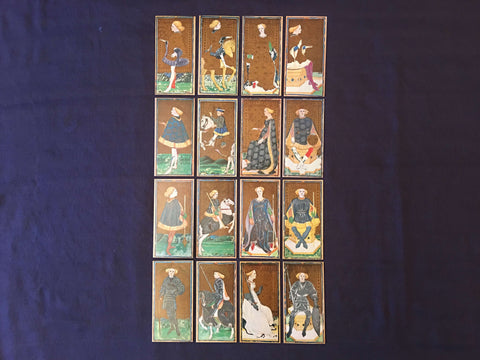The Visconti Tarot Deck
The Visconti Sforza Tarot deck is the oldest known Tarot deck. It was created around 1492 by Bonifacio Bembo, but it is likely that not all cards came from his hands due to his young age at the time. It is believed that some of the cards are made by the artist Antonio Cicognara. The occasion was a marriage between members of two Milanese families: Visconti and Sforza. It can be said that because of that event, the origins of the Tarot ‘game’ are Italian.

Much research has been done about this ‘Founding Father’ of all traditional tarot decks, so we will not elaborate any further about its history and background. However, in order to really get a grasp of the atmosphere and the society during those days, it is worthwhile to mention, (and read), the prelude to The Tarot Cards painted by Bonifacio Bembo by Gertrude Moakly (1905-1998) and published in 1966 by the New York Public Library, which we will try to reproduce hereafter, although abbreviated and rephrased. We mention this work with gratitude, giving all honors to Mrs. Moakly of course, who did a truly magnificent effort in creating and visualizing the exact atmosphere. Naturally, the book itself is more than worthwhile reading as it offers important research on the subject.
‘To understand the tarocchi let us imagine the scenes and symbols of the cards come to life in the milieu in which they originated. We see a beautifully dressed Duke of Milan (Francesco Sforza) waiting to review the last procession of ‘triumphs’ (Trionfi), with at his side the Duchess (Bianca Maria Visconti), the last living descendant of the Visconti Dukes. The procession is a long one, 22 triumphal cards (coincidence?) and along the streets people cheer and call out to the paraders. Finally, the first and the final Trionfi arrives at the stand where the Duke and the Duchess reside. The Carnival King Bagatino, seated on the triumphal car and eating his final meal before Carnival ends and he is (now only symbolically) killed. He starts yelling and mocks the Duke in a way no one under other circumstances would survive. God gets enthroned (the Duke), only to get resurrected the next moment. Love, Life, Intrigue and Death, Past and Present, it’s all there, in a perfect reflection of the complete Major Arcana of the Tarot... One by one follow all the others, each triumph doing a little sketch, telling joke’s or a small symbolical act, yelling, dancing, mocking all the time. People on the street, accompanying horsemen and soldiers, all jumbled up, are busying themselves with all kinds of things otherwise not tolerated. All in all, it is a wild happening where nobody of the ruling elite or the clergy is spared.’
p. 13-16 of The Tarot Cards painted by Bonifacio Bempo by Gertrude Moakly
In ‘Pre-Comte Court de Gebelin-times’ Tarocchi or tarot cards were not specifically used as a means for predicting [the future] or analyzing [the past]. They were meant to be a game to play or used as symbolical gifts during Carnival, when they were given to one another as a (mocking) gift of good fortune. After the festivities, they were ritually tossed in the fires, their ashes mingling with all the good and bad that went with it.
I Tarocchi Visconti Sforza reproduction published by Edizione ‘Il Meneghello’, Milano 2002.
Limited edition 119/1000.





